Our first assignment was to find and rebuild schools, which would be funded through a program called Students Rebuild with matching grants from Bezos Family Foundation and additional funds from Stiller Strong. Five schools were selected and are under construction. This sounds easy but there were challenges at every phase, idea, and decision we tried to implement.
- We budgeted our schools' construction cost, but costs turned out to be generally twice what we expected (close to U.S. prices).
- We developed our drawings as we normally would - including plans, sections and some details, but the contractors were not familiar with detailed drawings such as these and didn't really use them.
- We competitively bid our projects, but because contractors weren't accustomed to reading our drawings or preparing detailed bids, the prices came back varying from80,000 to16 million for the same project.
- We sought official sign-off by the Ministry of Education to allow us to begin construction, but found a reluctance to commit on paper for various reasons which caused serious delays.
- We began construction visiting the site every few days, but we found many construction errors that needed to be torn out and redone (like a foundation).
- We threw our hands in the air, ruminated, cried, paced the office, worked and worked some more. We adjusted, innovated and invented and have overcome nearly every obstacle we've come across by innovating and finding a way around it. It hasn't been easy and it's taken longer than anyone anticipated, but we're making progress. In 18+ months, we've established the Rebuilding Center with a group comprised of a 17 full time staff supported by 20 volunteers comprised of international architects and planners--with nearly half being Haitian nationals or Diaspora producing nearly 50 projects. The Rebuilding Center also has a marketing department, a full time accountant and an economic development arm that will eventually become the primary focus of the organization, owned and staffed by Haitians for the nation of Haiti. Architecture for Humanity is on an eight-year time table in Haiti with a goal of working itself out of a job and leaving behind an economic resource for rebuilding.
My year with Architecture for Humanity in Haiti is finished. I'm writing this from my kitchen counter in South Dakota re-experiencing endless frustrations and an incredible feeling of satisfaction. I will especially miss the Haitian people, those I worked with and those I greeted while walking to the bakery for lunch. The position I left as an American Institute of Architects/LEED AP Architect/Design Fellow is still open for another year-long contract. Check it out--it's an experience of a lifetime.

